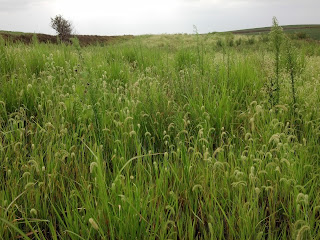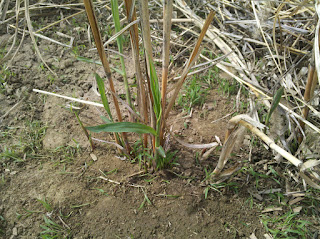Back in November we were able to attend and present at the
Small Farm Trade Show and Conference in Columbia, Missouri. This was a great experience and we were able to make an initial presentation on our project so far. We were able to also meet some very interesting people who are very concerned with the environment as well. I learned quite a bit about raised bed gardens and using humus to enhance soil. It really got me in the mood for making biochar. Then I met a researcher at the conference who was doing just that. John Topic had also won a grant through SARE and was researching improving soil by the use of biochar. Very interesting stuff and we hope to collaborate someday.
Following that not much to do on the farm but wait for the grass to dry out and drop the leaves. On December 28, 2011 I was able to go out to the field and try to hand harvest some of the plants. It was an unusually warm winter thus far, and not much had changed with the field since October.
 |
| Miscanthus field in late December |
I used a rake to remove the weed grass that had now laid down nicely to reveal the miscanthus grass that was still standing tall.I got a spot about 15'x15' cleared out so I could harvest neatly without contamination of the other grasses.
 |
| Small cleared patch. |
I used a corn knife to hand cut the miscanthus just above ground level. I took the plants whole in a bag back home. The biomass will need analysis for mineral and energy content.
 |
| Harvested bunch of miscanthus - single plant, first year |
After I was complete, that left a fairly bare patch in the field.
So I raked the grass back into the spot to help prevent any soil erosion during next spring.
What I really found interesting with the miscanthus plants is the very different physical properties of the plant stems versus the leaves. The stems separated very easily from the rest of the plant. I assume this is what should happen after winter with leaves have fully dropped from the plants. We will have to wait to see what winter brings us in terms of snow to see if that is true or not in the spring. Also, this field is first year growth that is practically an unharvestable quantity. We will have to wait until next fall to determine the final weight and volume percentage of the harvested grass is leaves compared to stems.




























